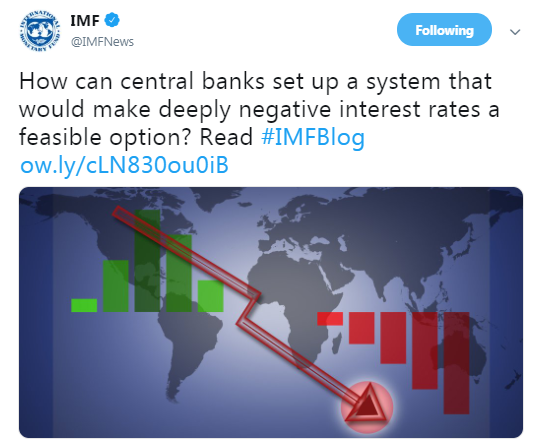Scrolling through my Twitter feed over the long weekend I came across something curious. Now curiosities, are of course, par for the course on Twitter (which is why I imagine a lot of folks use it), but this one stood out.
It was a question posed by the International Monetary Fund (IMF), written in an enthusiastic, jovial tone:
Oh yes, dear reader. We’re here again.
The last time questions like this were being shouted publicly from ivory towers important financial institutions, it was 2016. Economic growth around the world was slowing, and the great debts accrued by sovereigns, corporates, and everybody else getting heavier. The threat of global deflation had returned, Europe’s banks were in trouble as a result (is any of this sounding familiar?) and investors were piling into US government bonds for safety, which reached record low yields.
In short, the music was stopping, and our monetary overlords were looking for a means to print more chairs. Or in the case of negative interest rates, to break a piece off everybody else’s chair and then assemble a new one from the pieces. The War on Cash was in full swing, and conversations on the feasibility of phasing out physical cash completely in order to charge everybody negative interest rates were no longer behind closed doors, but right out in the open.
Then the Chinese Communist Party rolled out a massive stimulus programme, and managed to push all those problems aside. For a while. Demand from China gushed into the global economy, especially into Germany for cars and machinery. The German boom dragged up the European economy as a whole, and the world experienced a rise in growth. The problems of deflation and bad debts was put aside, and US bond yields rose as it looked like inflation might finally take off. As Tim Price would describe it, the War on Cash went from a hot war to a cold one.
But now here we are again. The reflation juice from China that has lasted the past few years has run out. US bond yields are falling once again and reflect a deflationary environment. The German economy which was pulling Europe up, is now dragging it down. It is now in an industrial recession, with factory orders have dived to levels only surpassed by 2008 since German reunification in the early 90s. The problems of Europe are very much at the fore once again.
While the Chinese are intent on injecting more stimulus, and many are hoping that they’ll save the day as they did three years ago, that stimulus is firmly targeted within China, and is unlikely to have a global spillover like in 2016.
And so our monetary overlords have, once again, begun discussing creative new ways in which savers can be bled to aid debtors…
Two prices at the shops?
That tweet links to an IMF article outlining a strategy where central banks split their currencies in two, in order to force negative interest rates upon everybody.
The citizenry can then use either digital money or physical cash for their transactions, but are bled by negative interest rates at every turn. This is achieved by charging negative interest on the digital money, and then setting a fixed exchange rate between physical cash and digital money that reflects that negative interest rate.
From the article, emphasis mine:
To illustrate, suppose your bank announced a negative 3 percent interest rate on your bank deposit of 100 dollars today. Suppose also that the central bank announced that cash-dollars would now become a separate currency that would depreciate against e-dollars by 3 percent per year. The conversion rate of cash-dollars into e-dollars would hence change from 1 to 0.97 over the year. After a year, there would be 97 e-dollars left in your bank account. If you instead took out 100 cash-dollars today and kept it safe at home for a year, exchanging it into e-money after that year would also yield 97 e-dollars.
At the same time, shops would start advertising prices in e-money and cash separately, just as shops in some small open economies already advertise prices both in domestic and in bordering foreign currencies. Cash would thereby be losing value both in terms of goods and in terms of e-money, and there would be no benefit to holding cash relative to bank deposits.
This dual local currency system would allow the central bank to implement as negative an interest rate as necessary for countering a recession, without triggering any large-scale substitutions into cash.
e-money would effectively replace physical cash as the base form of currency. Even if you held on to £100 in physical cash for a year in which there was a -5% interest rate, you would only ever be able to redeem it for £95 in e-money.
I’m a gold-nut. I’d probably want to own some gold no matter what the monetary environment is.
But boy, does the yellow metal look friendly these days.
Who knows if the IMF’s plan design will be taken seriously or be deemed politically palatable by national central banks. But they aren’t the only ones dwelling on the topic of negative nominal interest rates – and it’s something I expect we’ll be seeing a lot more of, especially if Chinese stimulus doesn’t reach Western shores.
All the best,
Boaz Shoshan
Editor, Capital & Conflict
Category: Market updates



